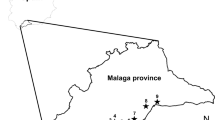Abstract
Feral pigeons (Columba livia, Gmelin 1789) cause different problems for building owners when using structures for daytime perching, sleeping, and breeding. Problems include fouling of building facades and pavements, transmission of allergens and pathogenic microorganisms, and infestations with ectoparasites emanating from breeding sites. Owners are primarily interested in keeping away unwanted pigeons from their property. Pest control companies offer different deterrent systems, of widely varying efficacy, for proofing buildings against feral pigeons. A better solution is avoiding attractive structures during building design or subsequent alterations of existing structures used by feral pigeons. With our study, we elaborate the relevant structural data to help to maintain a building free of pigeons. We performed experiments with free ranging feral pigeons in a feral pigeon loft in the City of Basel, Switzerland. The maximum outlet width a pigeon is not able to pass through is 4 cm; the respective outlet height is 5 cm and a pigeon-safe square opening is not larger than 6 × 6 cm. The maximum ledge width a pigeon is not able to sit on is 4 cm. The pigeon-safe angle of inclination for smooth construction materials (tinplate, glass, plastics) is 25°, for medium rough materials (wood, plane concrete) 35°, and for rough materials (sandstone, rough concrete) at least 50°. Additionally, we studied the behavioral strategies used by feral pigeons to surmount our experimental constructional restrictions, ledge width, and ledge inclinations. Our data provide the essential data to prevent feral pigeons from using building structures.










Similar content being viewed by others
References
Andelt WF, Burnham KP (1993) Effectiveness of nylon lines for deterring Rock Doves from landing on ledges. Wildl Soc Bull 21:451–456
Carle R (1959) Die Vorbereitung zur Bestandsregelung unter den verwilderten Haustauben in den Städten. Städtehygiene 8:164–168
Del Monte M, Sabbioni C (1986) Chemical and biological weathering of an historical building: Reggio Emilia Cathedral. Sci Total Environ 50:165–182
Dell’Omo A (1996) Il ruolo degli escrementi dei piccioni nella bioalterazione delle rocce. Tesina di Università degli Studi di Roma “La Sapienza", Facoltà di Scienze Matematiche, Fisiche e Naturali, Dipartimento di Biologia Animale e dell'Uomo
Fabricius E, Jansson AM (1963) Laboratory observations on the reproductive behaviour of the pigeon (Columba livia) during the pre-incubation phase of the breeding cycle. Anim Behav XI(4):534–547
Haag D (1984) Ein Beitrag zur Oekologie der Stadttaube. Dissertation, Phil. Nat. Faculty of the University of Basel, Verlag Medizinische Biologie, Basel, Switzerland
Haag D (1991a) Population density as a regulator of mortality among eggs and nestlings of feral pigeons (Columba livia domestica) in Basel, Switzerland. In: Proceedings of International Symposium of the Working Group on Granivorous Birds, INTECOL, Slupsk, Poland, Sept 14–17 1989, Warzawa: J. Pinowski, B. P. Kavanagh and W. Gorski, PWN—Polish Scientific Publishers, Warzawa: 21–31
Haag D (1991b) Ethogramm der Taube. Ruhr University, Bochum Published in the series “Orn-Projekt”
Haag-Wackernagel D (1995) Regulation of the street pigeon in Basel. Wildl Soc Bull 23(2):256–260
Haag-Wackernagel D (2000) Behavioural responses of the feral pigeon (Columbidae) to deterring systems. Folia Zoologica 49(2):25–39
Haag-Wackernagel D (2005) Parasites from feral pigeons as a health hazard for humans. Ann Appl Biol 147:203–210
Haag-Wackernagel D (2006) Human diseases caused by feral pigeons. Advances in Vertebrate Pest Management 4:31–58
Haag-Wackernagel D, Moch H (2004) Health hazards posed by feral pigeons. J Inf 48(4):307–313
Johnston RF, Janiga M (1995) Feral Pigeons. Oxford University Press, Oxford
Kern WH (2007) Pigeons. Fact Sheet SS-WEC-117 (UW117) Department of Wildlife Ecology and Conservation, Florida Cooperative Extension Service, Institute of Food and Agricultural Sciences, University of Florida. http://edis.ifas.ufl.edu/UW117
Kösters J, Kaleta EF, Monreal G, Siegmann O (1991) Das Problem der Stadttauben. Deutsches Tierärzteblatt 4:272–276
Landesamt fur Arbeitsschutz, Gesundheitsschutz und Technische Sicherheit Berlin (2000). Massnahmen der Taubenvergrämung. Fachinfo 1/2000, http://www.hygieneinspektoren.de/download/tauben.pdf
Murton RK, Thearle RJP, Thompson J (1972) Ecological studies of the feral pigeon Columba livia var. I. Population, breeding biology and methods of control. J Appl Ecol 9:835–874
Simms E (1979) The public life of the Street Pigeon. Hutchinson, London
Thurston P (1983) Bauen für Segler. Gartenbauamt der Stadt Zürich
Wormuth HJ (1994) Zum Problem der verwilderten Haustauben. Merkblatt des Robert von Ostertag-Instituts des Bundesgesundheitsamtes, Berlin, p 6
Acknowledgments
We are very grateful to Andreas Ochsenbein for technical support and assistance. We thank Chris Feare for his valuable comments and amendments.
All experiments were performed with the animal experimental permission of the Cantonal Veterinary Office of Basel-Town, Switzerland (authorization no. 2121 of the 16 Feb. 2006) and conformed to Swiss law on animal welfare.
Author information
Authors and Affiliations
Corresponding author
Additional information
Communicated by W. Lutz
Rights and permissions
About this article
Cite this article
Haag-Wackernagel, D., Geigenfeind, I. Protecting buildings against feral pigeons. Eur J Wildl Res 54, 715–721 (2008). https://doi.org/10.1007/s10344-008-0201-z
Received:
Revised:
Accepted:
Published:
Issue Date:
DOI: https://doi.org/10.1007/s10344-008-0201-z




